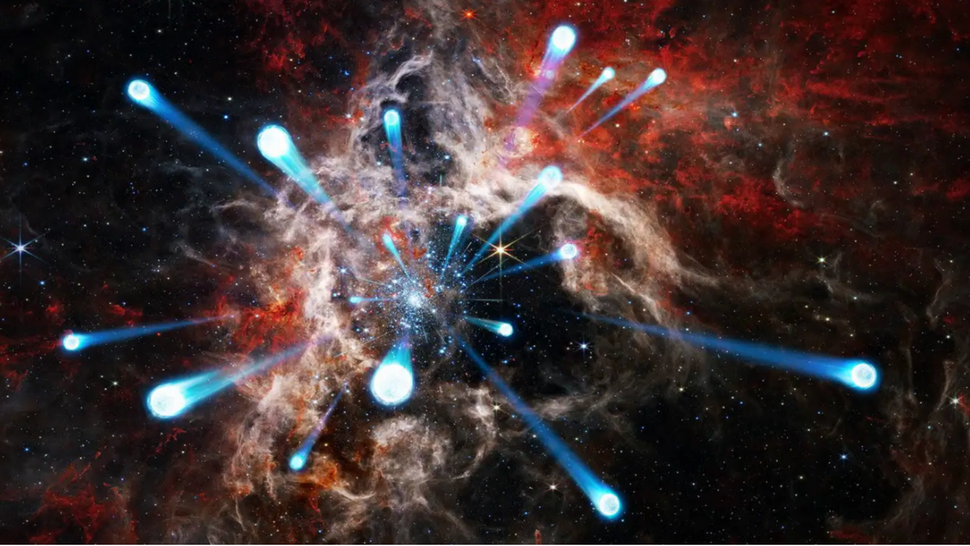Science
Related: About this forumGaia space telescope discovers 55 'runaway' careening away from stellar cluster at 80 times the speed of sound
By Robert Lea published 5 hours ago
"Discovering something new is always a thrill for a scientist."

An illustration of the star cluster R136 in the Large Magellanic Cloud ejecting runaway stars (Image credit: Danielle Futselaar, James Webb Space Telescope/NIRCam - NASA, ESA, CSA and STScI.)
Using Europe's Gaia space telescope, astronomers have identified 55 runaway stars being ejected at high speeds from a densely packed young cluster in the Large Magellanic Cloud (LMC), a satellite galaxy of our own Milky Way. This is the first time so many stars have been seen escaping from a single star cluster.
The star cluster R136, located around 158,000 light-years away, is home to hundreds of thousands of stars and sits in a massive region of intense star formation in the LMC. It's home to some of the biggest stars ever seen by astronomers, some with 300 times the mass of the sun.
The runaway stars were ejected in two bursts over the last two million years. Some of them are racing away from their homes at over 62,000 mph (100,000 kph) — about 80 times as fast as the speed of sound on Earth. The runaways massive enough to die in supernovas, leaving behind black holes or neutron stars, will behave like cosmic missiles, exploding up to 1,000 light-years from their origin point.
The discovery was made by a team of astronomers led by University of Amsterdam researcher Mitchel Stoop using Gaia, which precisely monitors the positions of billions of stars. The findings increase the number of known runaway stars by a factor of 10.
Scientists think that stars are exiled from young star clusters like R136 — which is estimated to be less than 2 million years old (that may seem ancient, but compare it to our 4.6 billion-year-old solar system) — when crowded stellar newborns cross paths and cause orbits to be gravitationally disrupted. What surprised the team, however, was the revelation that more than one major escape event had happened in R136, and the second one happened quite recently (in cosmic terms, at least).
More:
https://www.space.com/the-universe/stars/gaia-space-telescope-discovers-55-runaway-careening-away-from-stellar-cluster-at-80-times-the-speed-of-sound
Permanut
(6,636 posts)The forces and energy levels are so incredible to toss stars around like ping pong balls.
Metaphorical
(2,308 posts)They likely are, though the LMC is fairly diffuse by now, meaning that these runaway stars may well have exceeded escape velocity.
Batshit_Bruin_CA
(54 posts)At 62,000 mph, allegedly going 80 times the speed of sound on earth, I came up with speed of sound on earth as 775 mph. Now that number seems a bit high but it varies with a number of factors. Altitude above sea level (i. e. Density of air at a certain height), temperature of the air, and humidity; and whether you want average in speed of sound in seawater (oceans, lakes, etc).
So none of that bit about calculations takes away from that report of unique and awesome phenomena displayed in that specific galaxy. It's kinda mind-blowing. Their relatively short lifespans are also fascinating. But seem difficult to understand.